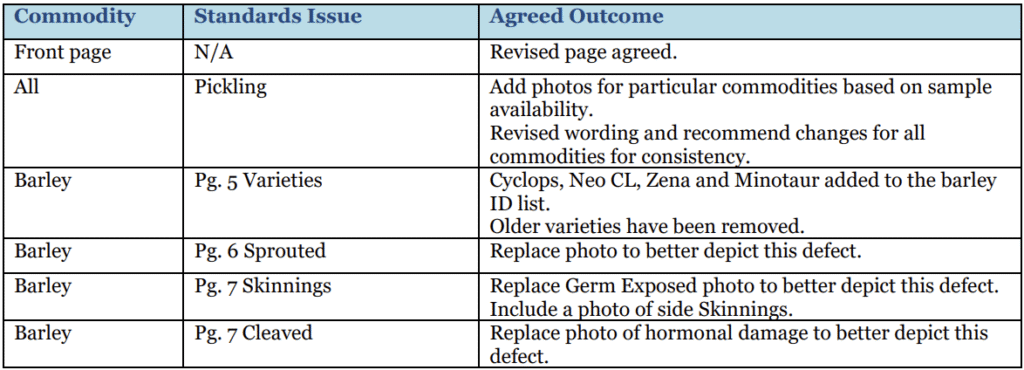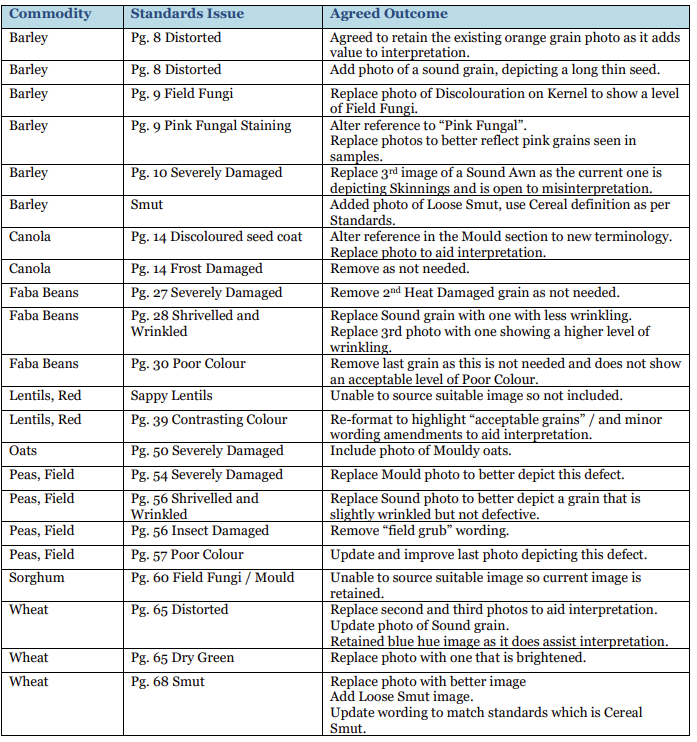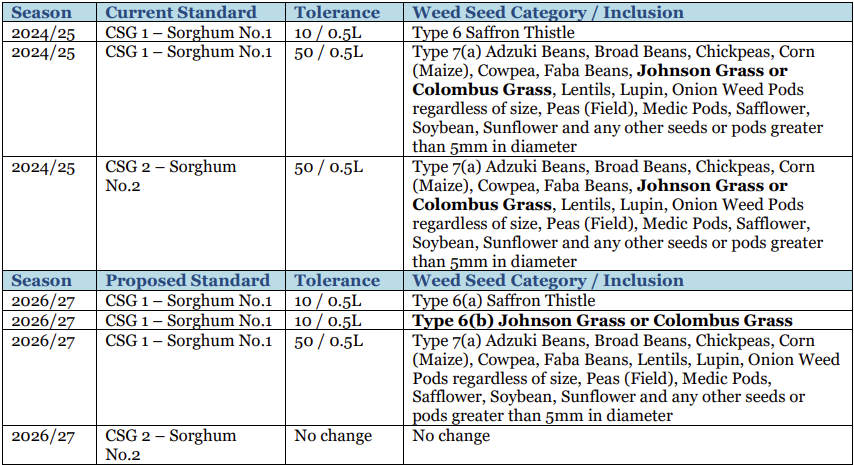
DISTRIBUTION: GTA Members – primary contact list. Please circulate to all appropriate internal parties.
1. Issue
Member Update 2 of 25 sought industry comment on potential changes to Trading Standards for 2025/26 season and also outlined a range of issues for industry consideration.
The GTA Trading Standards Committee (Committee) has recently met to discuss industry feedback received and the potential Standards for 2025/26.
This document is provided for further industry consideration and feedback.
2. Process for Industry Feedback
The Committee is seeking industry comment on the issues outlined in this document and on any other Standards related issue.
Submissions should be received by COB Friday, 16 May 2025.
Please lodge your submissions by sending to submissions@graintrade.org.au and title your email – Standards Review 2025/26.
Industry is encouraged to provide supporting evidence for any change proposed in Standards. Preference is for industry to use the proforma for lodging submissions located on the GTA website.
Unless marked “confidential” and appropriate supporting reasons are provided, all submissions will be placed on the GTA website for industry review.
3. Agreed Changes for Adoption in 2025/26
3.1 Agreed Change: Visual Recognition Standards Guide – All Commodities
The Committee has decided that there are several minor amendments that may add value to the existing version of the VRSG. As such, the Committee will re-publish a revised version for 2025/26 with the following changes proposed.


3.2 Agreed Change: Minor Wording Changes & Other Issues – Cereal & Pulse Commodities
Minor changes to wording in all relevant Standards charts and Standards booklets will occur. These changes will refer to the latest versions of reference material available to assist industry implementation of Standards, including:
3.3 Agreed Change: Varietal Master List – Wheat, Barley, Oats
As in previous seasons, the Varietal Master List for the above commodities will be reviewed following receipt of relevant changes from the industry sector responsible for the classification of those grain varieties. GTA will also for all commodities (except mung beans):
3.4 Agreed Change: Procedures – All Pulse Commodities Except Mung Beans
Industry was advised during 2024 that as GTA now develops the Pulse Trading Standards (except mung beans) on behalf of industry, the Committee had commenced revising the Pulse Standards Booklet with the intention of making the Booklet appear as per cereals. While some procedures were revised for the 2024/25 Standards Booklet, several remained to be done, and the Committee is developing a number of the remaining procedures during 2025 where technically feasible, and timeframes allow.
The revised Procedures will be published in the Pulse Trading Standards Booklet for 2025/26 when released to industry on 1 August 2025.
3.5 Agreed Change: AGP1 for 2026/27 – Wheat
The current specification for Falling Number (FN) for AGP1 is a minimum of 200 seconds. A submission was received indicating there is no market demand for AGP1 that has a FN of below 250 seconds due to the negative quality of the resulting flour. The Committee noted that in general, where the average FN of wheat stacks are below 250 seconds, the grain goes to the Feed market.
The submission requested the Committee to consider a change in FN for AGP1 from a minimum of 200 seconds to 250 seconds. The main intent of the change was to bring AGP1 into alignment with other off grade milling wheats for FN.
The Committee noted that the use of AGP1 had changed over time and AGP1 below 250 seconds was generally significantly discounted. Discussion also arose on the potential to also change other AGP1 parameters to those of AUH2, however the Committee considered there was no need at present.
The Committee agreed to a change in the minimum FN for AGP1 from 200 seconds to 250 seconds, to apply for the 2026/27 season and industry comment is sought.
3.6 Agreed Change: Barley1 and Barley2 Grade Names – Barley
In developing the 2024/25 Standards, industry was advised:
Therefore, in the 2024/25 Barley Standards where there was a reference to Barley1 and Barley2 the following words for clarification purposes only were added:
Barley1 and Barley2 Grades (Commonly known within industry as BAR1 and BAR2)
Industry was also advised that during development of the 2025/2026 Trading Standards, a more formal change of the Grade names from Barley1 and Barley2 to BAR1 and BAR2 respectively would occur.
The Committee has agreed to this change for the 2025/26 season.
3.7 Johnson Grass / Columbus Grass Tolerance for 2026/27 – Sorghum
Industry was advised of various options to alter the tolerance for Johnson Grass / Columbus Grass in sorghum Trading Standards in the first call for industry submissions. The driver for a potential change was a submission received from industry seeking a change in the current tolerance as the current tolerance of 50 seeds / 0.5L significantly exceeds the tolerance required by a major market for Australian sorghum. The difference makes sourcing grain and supplying the market difficult.
Two submissions on this subject were received calling for the limit for Johnson Grass/Columbus Grass be reduced from 50 to 10 seeds per half litre, with the other seeking a reduction for Sorghum No. 1 only.
The Committee noted:
Following discussion, the Committee agreed to seek further industry submissions on an agreed position to reduce the tolerance for Johnson Grass/Columbus Grass in No.1 from 50 seeds/0.5L to 10 seeds/0.5L for the 2026/27 season. No change to No.2 would occur. For clarity, the Committee agreed to the following:

No change would occur for the 2025/26 season.
3.8 Agreed Change: Colour References for 2026/27 – Broad Beans
In the first call for industry submissions industry was advised the current Broad Bean Standards have various references to colour, including evergreens, old seasons, dark beans, black beans and beans that are “distinctly off colour from the characteristic colour of the predominating class”.
A review of those various references has occurred, and the findings of the Committee are outlined below.
In current Standards:

The Committee discussed this issue and determined:
Following discussion, the Committee agreed to seek industry comments on the following change for 2026/27:
For clarity, the tolerances that would apply are as follows:

3.9 Agreed Change: Screen Size – Fenugreek
The Fenugreek Standards reference a screen and include “all Fenugreek seed material falling through the screen” in the Total Defective category. However, despite previous attempts for information, an appropriate screen size could not be obtained for reference in the Standard to assist industry interpretation.
The Committee has received advice that a 1.4mm slotted screen is appropriate, hence it is proposed to reference this screen in the 2025/26 Fenugreek Standards in the following areas:
4. Issues for Further Ongoing Consideration
4.1 Further Research: Vacuum Sampling of Road Trucks – All Commodities
The project to review the appropriateness of sampling systems on receival from road trucks has completed its initial phase. Based on initial findings, further research was highlighted as needed and is now being undertaken by the Grains Research and Development Corporation (GRDC).
Industry will be advised of findings in due course.
4.2 Further Review: SFW1 – Wheat
Industry was advised in 2020 of a submission requesting a change in the tolerances for a range of defective grain types in the SFW1 grade. That submission in total was not supported and no changes to the tolerances occurred. Since that time, a further submission requesting changes to Field Fungi and Severely Damaged grains only was received.
The submission requested changes as follows:
Discussion by the Committee on this topic included:
The Committee continues consultation on the proposed changes with the stockfeed sector. Industry will be advised of the findings during 2025.
4.3 Further Review: Varietal Assessment – Barley
The Committee has been undertaking a review at the request of a technology provider, of the use of technology to identify barley varieties under a test protocol developed by GTA on behalf of industry. If approved, that technology would be referenced in the Barley Standards as an approved unit for testing particular barley varieties.
As the review process is still underway, a final decision cannot be made at this time. However, industry will be advised in due course of the results of the assessment and the Committee’s decision when the Barley Trading Standards for 2025/26 are released.
5 Matters Where No Further Action is Required
5.1 No Change: Defect Assessment Method – All Commodities
A submission was received from industry noting that percentage by count for defects is considered too time consuming for use as a field method for grain assessment. As a consequence, the Trading Standards has historically used percentage by weight for assessment of defects.
The submission stated that new visual assessment technology can assess defects as a percentage by count and the conversion to weight is an unnecessary added step. The submission requested the Committee consider applying a percentage by count for future available technology when assessing defects.
The Committee noted:
As these issues need to be considered in future when technology is more readily available or impending for all commodities, no change is warranted to existing Standards.
5.2 No change: Kabuli Chickpeas – Sizing
The current Kabuli Chickpea Standards refers to small as 5-6mm in diameter and large as greater than 6mm in diameter. The Committee had been advised that there may be a difference in the view of breeders/classification of Kabuli Chickpeas, with any Kabuli less than 8mm considered small.
The Committee has determined the marketing of chickpeas is different than breeding and the sizing differences are valid.
No change to Standards is proposed for 2025/26 Standards.
Member Update No. 23 of 2025 – GTA Board Appointments 2025-2026
29 October 2025
Member Update No. 19 of 2025 – GTA Annual General Meeting 2025 Notice
26 September 2025
Stay updated on industry news and events. Subscribe now for exclusive updates and insights!
Self Regulatory Framework
NEWS
Self Regulatory Framework
NWPGP
NEWS
Events
Street Address
Level 7
12 O'Connell Street
Sydney NSW 2000
Postal Address
PO Box R1829
Royal Exchange
Sydney NSW 1225
Street Address
Level 7
12 O'Connell Street
Sydney NSW 2000
Postal Address
PO Box R1829
Royal Exchange
Sydney NSW 1225